一、Spring Boot 入门
1、Spring Boot 简介
简化Spring应用开发的一个框架;
整个Spring技术栈的一个大整合;
J2EE开发的一站式解决方案;
2、微服务
2014,martin fowler
微服务:架构风格(服务微化)
一个应用应该是一组小型服务;可以通过HTTP的方式进行互通;
单体应用:ALL IN ONE
微服务:每一个功能元素最终都是一个可独立替换和独立升级的软件单元;
3、环境准备
http://www.gulixueyuan.com/ 谷粒学院
环境约束
–jdk1.8:Spring Boot 推荐jdk1.7及以上;java version “1.8.0_112”
–maven3.x:maven 3.3以上版本;Apache Maven 3.3.9
–IntelliJIDEA2017:IntelliJ IDEA 2017.2.2 x64、STS
–SpringBoot 1.5.9.RELEASE:1.5.9;
统一环境;
1、MAVEN设置;
给maven 的settings.xml配置文件的profiles标签添加
1 | <profile> |
2、IDEA设置
整合maven进来;


4、Spring Boot HelloWorld
一个功能:
浏览器发送hello请求,服务器接受请求并处理,响应Hello World字符串;
1、创建一个maven工程;(jar)
2、导入spring boot相关的依赖
1 | <parent> |
3、编写一个主程序;启动Spring Boot应用
1 |
|
4、编写相关的Controller、Service
1 |
|
5、运行主程序测试
6、简化部署
1 | <!-- 这个插件,可以将应用打包成一个可执行的jar包;--> |
将这个应用打成jar包,直接使用java -jar的命令进行执行;
5、Hello World探究
1、POM文件
1、父项目
1 | <parent> |
Spring Boot的版本仲裁中心;
以后我们导入依赖默认是不需要写版本;(没有在dependencies里面管理的依赖自然需要声明版本号)
2、启动器
1 | <dependency> |
spring-boot-starter-==web==:
spring-boot-starter:spring-boot场景启动器;帮我们导入了web模块正常运行所依赖的组件;
Spring Boot将所有的功能场景都抽取出来,做成一个个的starters(启动器),只需要在项目里面引入这些starter相关场景的所有依赖都会导入进来。要用什么功能就导入什么场景的启动器
2、主程序类,主入口类
1 | /** |
@SpringBootApplication: Spring Boot应用标注在某个类上说明这个类是SpringBoot的主配置类,SpringBoot就应该运行这个类的main方法来启动SpringBoot应用;
1 | (ElementType.TYPE) |
@SpringBootConfiguration:Spring Boot的配置类;
标注在某个类上,表示这是一个Spring Boot的配置类;
@Configuration:配置类上来标注这个注解;
配置类 —– 配置文件;配置类也是容器中的一个组件;@Component
@EnableAutoConfiguration:开启自动配置功能;
以前我们需要配置的东西,Spring Boot帮我们自动配置;@EnableAutoConfiguration告诉SpringBoot开启自动配置功能;这样自动配置才能生效;
1 |
|
@AutoConfigurationPackage:自动配置包
@Import(AutoConfigurationPackages.Registrar.class):
Spring的底层注解@Import,给容器中导入一个组件;导入的组件由AutoConfigurationPackages.Registrar.class;
==将主配置类(@SpringBootApplication标注的类)的所在包及下面所有子包里面的所有组件扫描到Spring容器;==
@Import(EnableAutoConfigurationImportSelector.class);
给容器中导入组件?
EnableAutoConfigurationImportSelector:导入哪些组件的选择器;
将所有需要导入的组件以全类名的方式返回;这些组件就会被添加到容器中;
会给容器中导入非常多的自动配置类(xxxAutoConfiguration);就是给容器中导入这个场景需要的所有组件,并配置好这些组件;
有了自动配置类,免去了我们手动编写配置注入功能组件等的工作;
SpringFactoriesLoader.loadFactoryNames(EnableAutoConfiguration.class,classLoader);
==Spring Boot在启动的时候从类路径下的META-INF/spring.factories中获取EnableAutoConfiguration指定的值,将这些值作为自动配置类导入到容器中,自动配置类就生效,帮我们进行自动配置工作;==以前我们需要自己配置的东西,自动配置类都帮我们;
J2EE的整体整合解决方案和自动配置都在spring-boot-autoconfigure-1.5.9.RELEASE.jar;
==Spring注解版(谷粒学院)==
6、使用Spring Initializer快速创建Spring Boot项目
1、IDEA:使用 Spring Initializer快速创建项目
IDE都支持使用Spring的项目创建向导快速创建一个Spring Boot项目;
选择我们需要的模块;向导会联网创建Spring Boot项目;
默认生成的Spring Boot项目;
- 主程序已经生成好了,我们只需要我们自己的逻辑
- resources文件夹中目录结构
- static:保存所有的静态资源; js css images;
- templates:保存所有的模板页面;(Spring Boot默认jar包使用嵌入式的Tomcat,默认不支持JSP页面);可以使用模板引擎(freemarker、thymeleaf);
- application.properties:Spring Boot应用的配置文件;可以修改一些默认设置;
2、STS使用 Spring Starter Project快速创建项目
二、配置文件
1、配置文件
SpringBoot使用一个全局的配置文件,配置文件名是固定的;
•application.properties
•application.yml
配置文件的作用:修改SpringBoot自动配置的默认值;SpringBoot在底层都给我们自动配置好;
YAML(YAML Ain’t Markup Language)
YAML A Markup Language:是一个标记语言
YAML isn’t Markup Language:不是一个标记语言;
标记语言:
以前的配置文件;大多都使用的是 xxxx.xml文件;
YAML:以数据为中心,比json、xml等更适合做配置文件;
YAML:配置例子
1 | server: |
XML:
1 | <server> |
2、YAML语法:
1、基本语法
k:(空格)v:表示一对键值对(空格必须有);
以空格的缩进来控制层级关系;只要是左对齐的一列数据,都是同一个层级的
1 | server: |
属性和值也是大小写敏感;
2、值的写法
字面量:普通的值(数字,字符串,布尔)
k: v:字面直接来写;
字符串默认不用加上单引号或者双引号;
“”:双引号;不会转义字符串里面的特殊字符;特殊字符会作为本身想表示的意思
name: “zhangsan \n lisi”:输出;zhangsan 换行 lisi
‘’:单引号;会转义特殊字符,特殊字符最终只是一个普通的字符串数据
name: ‘zhangsan \n lisi’:输出;zhangsan \n lisi
对象、Map(属性和值)(键值对):
k: v:在下一行来写对象的属性和值的关系;注意缩进
对象还是k: v的方式
1 | friends: |
行内写法:
1 | friends: {lastName: zhangsan,age: 18} |
数组(List、Set):
用- 值表示数组中的一个元素
1 | pets: |
行内写法
1 | pets: [cat,dog,pig] |
3、配置文件值注入
配置文件
1 | person: |
javaBean:
1 | /** |
我们可以导入配置文件处理器,以后编写配置就有提示了
1 | <!--导入配置文件处理器,配置文件进行绑定就会有提示--> |
1、properties配置文件在idea中默认utf-8可能会乱码
调整乱码
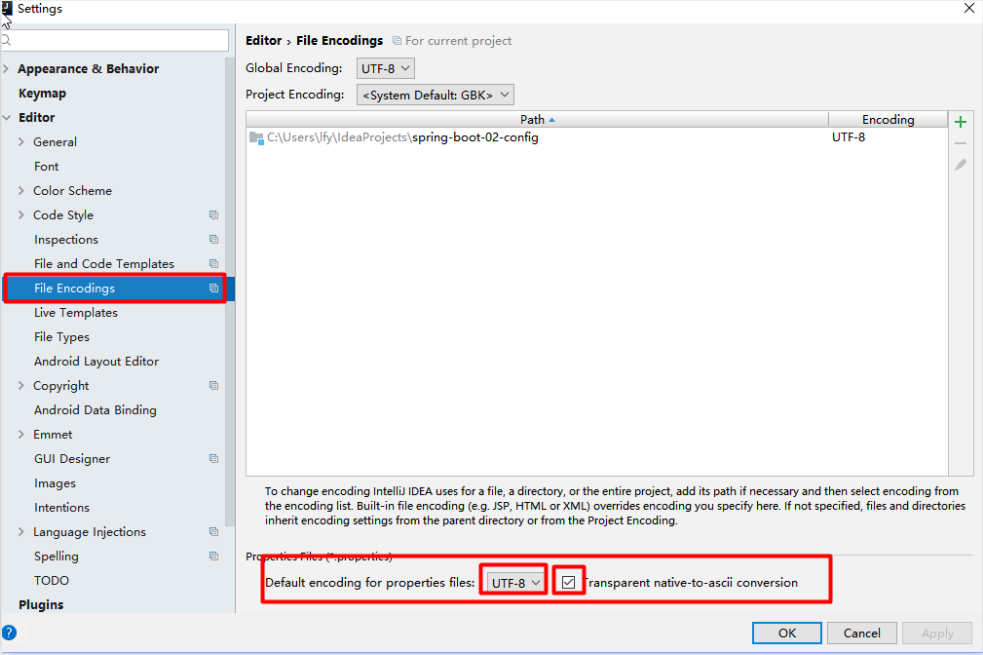
2、@Value获取值和@ConfigurationProperties获取值比较
| @ConfigurationProperties | @Value | |
|---|---|---|
| 功能 | 批量注入配置文件中的属性 | 一个个指定 |
| 松散绑定(松散语法) | 支持 | 不支持 |
| SpEL | 不支持 | 支持 |
| JSR303数据校验 | 支持 | 不支持 |
| 复杂类型封装 | 支持 | 不支持 |
配置文件yml还是properties他们都能获取到值;
如果说,我们只是在某个业务逻辑中需要获取一下配置文件中的某项值,使用@Value;
如果说,我们专门编写了一个javaBean来和配置文件进行映射,我们就直接使用@ConfigurationProperties;
3、配置文件注入值数据校验
1 |
|
4、@PropertySource&@ImportResource&@Bean
@PropertySource:加载指定的配置文件;
1 | /** |
@ImportResource:导入Spring的配置文件,让配置文件里面的内容生效;
Spring Boot里面没有Spring的配置文件,我们自己编写的配置文件,也不能自动识别;
想让Spring的配置文件生效,加载进来;@ImportResource标注在一个配置类上
1 | (locations = {"classpath:beans.xml"}) |
不来编写Spring的配置文件
1 |
|
SpringBoot推荐给容器中添加组件的方式;推荐使用全注解的方式
1、配置类@Configuration——>Spring配置文件
2、使用@Bean给容器中添加组件
1 | /** |
##4、配置文件占位符
1、随机数
1 | ${random.value}、${random.int}、${random.long} |
2、占位符获取之前配置的值,如果没有可以是用:指定默认值
1 | person.last-name=张三${random.uuid} |
5、Profile
(spring.profile.active={profile},指定运行哪一个配置文件)
1、多Profile文件
我们在主配置文件编写的时候,文件名可以是 application-{profile}.properties/yml
{profile}是作为标识,可以自定义名称
默认使用application.properties的配置;
2、yml支持多文档块方式
1 |
|
3、激活指定profile
1、在配置文件中指定 spring.profiles.active=dev
2、命令
项目内可以Edit Configuration中添加命令行运行
可以直接在测试的时候,配置传入命令行参数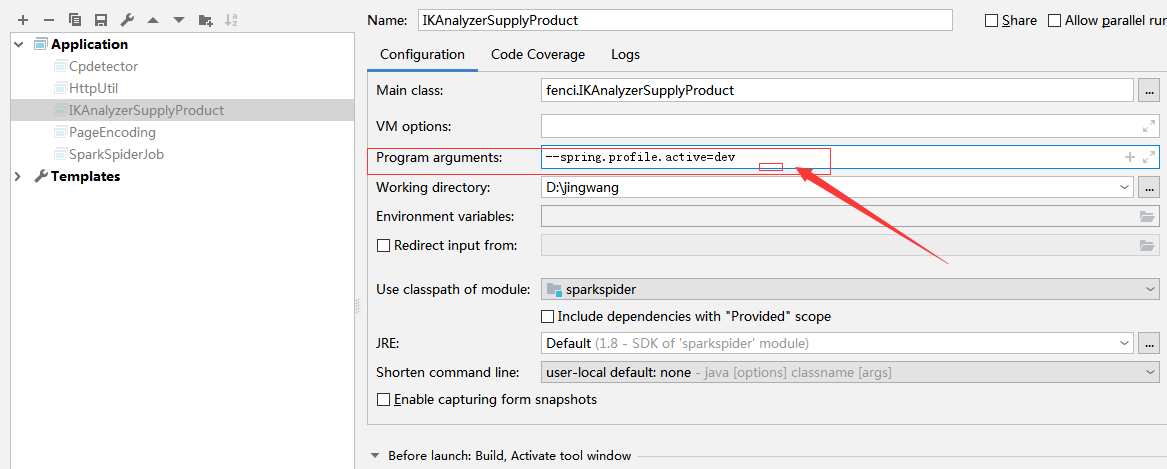
maven打包好jar包后在cmd中
java -jar spring-boot-02-config-0.0.1-SNAPSHOT.jar –spring.profiles.active=dev;
3、虚拟机参数;上图的VM option中
-Dspring.profiles.active=dev
6、配置文件加载位置
springboot 启动会扫描以下位置的application.properties或者application.yml文件作为Spring boot的默认配置
- 项目内 读取配置文件的优先级别是,springBoot都会读取,同样的配置按优先级使用,不同的配置会互补使用
- 根目录下config文件夹下的配置文件
- 根目录下的配置文件
- resource下的config下的配置文件
- resource 下的配置文件
与上述一一对应
– file:./config/
– file:./
– classpath:/config/
– classpath:/
优先级由高到底,高优先级的配置会覆盖低优先级的配置;
SpringBoot会从这四个位置全部加载主配置文件;互补配置;
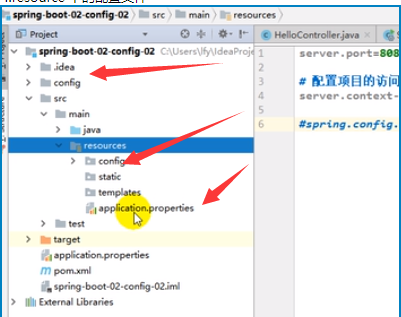
==我们还可以通过spring.config.location来改变默认的配置文件位置==
项目打包好以后,我们可以使用命令行参数的形式,启动项目的时候来指定配置文件的新位置;指定配置文件和默认加载的这些配置文件共同起作用形成互补配置;
java -jar spring-boot-02-config-02-0.0.1-SNAPSHOT.jar –spring.config.location=G:/application.properties
7、外部配置加载顺序
==SpringBoot也可以从以下位置加载配置; 优先级从高到低;高优先级的配置覆盖低优先级的配置,所有的配置会形成互补配置==
1.命令行参数
所有的配置都可以在命令行上进行指定
java -jar spring-boot-02-config-02-0.0.1-SNAPSHOT.jar –server.port=8087 –server.context-path=/abc
多个配置用空格分开; –配置项=值
2.来自java:comp/env的JNDI属性
3.Java系统属性(System.getProperties())
4.操作系统环境变量
5.RandomValuePropertySource配置的random.*属性值
==由jar包外向jar包内进行寻找;==
==优先加载带profile==
6.jar包外部的application-{profile}.properties或application.yml(带spring.profile)配置文件
7.jar包内部的application-{profile}.properties或application.yml(带spring.profile)配置文件
==再来加载不带profile==
8.jar包外部的application.properties或application.yml(不带spring.profile)配置文件
9.jar包内部的application.properties或application.yml(不带spring.profile)配置文件
10.@Configuration注解类上的@PropertySource
11.通过SpringApplication.setDefaultProperties指定的默认属性
所有支持的配置加载来源;
8、自动配置原理
配置文件到底能写什么?怎么写?自动配置原理;
1、自动配置原理:
1)、SpringBoot启动的时候加载主配置类,开启了自动配置功能 ==@EnableAutoConfiguration==
2)、@EnableAutoConfiguration 作用:
- 利用EnableAutoConfigurationImportSelector给容器中导入一些组件?
可以查看selectImports()方法的内容;
List
configurations = getCandidateConfigurations(annotationMetadata, attributes);获取候选的配置 1
2
3
4SpringFactoriesLoader.loadFactoryNames()
扫描所有jar包类路径下 META-INF/spring.factories
把扫描到的这些文件的内容包装成properties对象
从properties中获取到EnableAutoConfiguration.class类(类名)对应的值,然后把他们添加在容器中
==将 类路径下 META-INF/spring.factories 里面配置的所有EnableAutoConfiguration的值加入到了容器中;==
也就是说自动配置就是在运行时,由于加入了@SpringBootApplication注解,该注解里面的的底层里有一个方法,就是扫描所有jar包寻找EnableAutoConfiguration.class类(类名)对应的值,且把他们添加到容器中运行,从而达到了自动配置的效果
1 | # Auto Configure |
每一个这样的 xxxAutoConfiguration类都是容器中的一个组件,都加入到容器中;用他们来做自动配置;
3)、每一个自动配置类进行自动配置功能;
4)、以HttpEncodingAutoConfiguration(Http编码自动配置)为例解释自动配置原理;
1 | //表示这是一个配置类,以前编写的配置文件一样,也可以给容器中添加组件 |
根据当前不同的条件判断,决定这个配置类是否生效?
一但这个配置类生效;这个配置类就会给容器中添加各种组件;这些组件的属性是从对应的properties类中获取的,这些类里面的每一个属性又是和配置文件绑定的;
5)、所有在配置文件中能配置的属性都是在xxxxProperties类中封装者‘;配置文件能配置什么就可以参照某个功能对应的这个属性类
1 | (prefix = "spring.http.encoding") //从配置文件中获取指定的值和bean的属性进行绑定 |
精髓:
1)、SpringBoot启动会加载大量的自动配置类
2)、我们看我们需要的功能有没有SpringBoot默认写好的自动配置类;
3)、我们再来看这个自动配置类中到底配置了哪些组件;(只要我们要用的组件有,我们就不需要再来配置了)
4)、给容器中自动配置类添加组件的时候,会从properties类中获取某些属性。我们就可以在配置文件中指定这些属性的值;
xxxxAutoConfigurartion:自动配置类;
给容器中添加组件
xxxxProperties:封装配置文件中相关属性;
2、细节
1、@Conditional派生注解(Spring注解版原生的@Conditional作用)
作用:必须是@Conditional指定的条件成立,才给容器中添加组件,配置配里面的所有内容才生效;
| @Conditional扩展注解 | 作用(判断是否满足当前指定条件) |
|---|---|
| @ConditionalOnJava | 系统的java版本是否符合要求 |
| @ConditionalOnBean | 容器中存在指定Bean; |
| @ConditionalOnMissingBean | 容器中不存在指定Bean; |
| @ConditionalOnExpression | 满足SpEL表达式指定 |
| @ConditionalOnClass | 系统中有指定的类 |
| @ConditionalOnMissingClass | 系统中没有指定的类 |
| @ConditionalOnSingleCandidate | 容器中只有一个指定的Bean,或者这个Bean是首选Bean |
| @ConditionalOnProperty | 系统中指定的属性是否有指定的值 |
| @ConditionalOnResource | 类路径下是否存在指定资源文件 |
| @ConditionalOnWebApplication | 当前是web环境 |
| @ConditionalOnNotWebApplication | 当前不是web环境 |
| @ConditionalOnJndi | JNDI存在指定项 |
自动配置类必须在一定的条件下才能生效;
我们怎么知道哪些自动配置类生效;
==我们可以通过在配置文件加一句 debug=true属性;运行后,来让控制台打印自动配置报告==,这样我们就可以很方便的知道哪些自动配置类生效;
1 | ========================= |
三、日志
1、日志框架
小张;开发一个大型系统;
1、System.out.println(“”);将关键数据打印在控制台;去掉?写在一个文件?
2、框架来记录系统的一些运行时信息;日志框架 ; zhanglogging.jar;
3、高大上的几个功能?异步模式?自动归档?xxxx? zhanglogging-good.jar?
4、将以前框架卸下来?换上新的框架,重新修改之前相关的API;zhanglogging-prefect.jar;
5、JDBC—数据库驱动;
写了一个统一的接口层;日志门面(日志的一个抽象层);logging-abstract.jar;
给项目中导入具体的日志实现就行了;我们之前的日志框架都是实现的抽象层;
市面上的日志框架;
JUL、JCL、Jboss-logging、logback、log4j、log4j2、slf4j….
| 日志门面 (日志的抽象层) | 日志实现 |
|---|---|
| Log4j JUL(java.util.logging) Log4j2 Logback |
左边选一个门面(抽象层)、右边来选一个实现;
日志门面: (抽象层) SLF4J;
日志实现:Logback;
SpringBoot:底层是Spring框架,Spring框架默认是用JCL;‘
*==SpringBoot选用 SLF4j和logback;==
2、SLF4j使用
1、如何在系统中使用SLF4j https://www.slf4j.org
以后开发的时候,日志记录方法的调用,不应该来直接调用日志的实现类,而是调用日志抽象层里面的方法;
给系统里面导入slf4j的jar和 logback的实现jar
1 | import org.slf4j.Logger; |
图示
SLF$4J与其他日志实现的关系图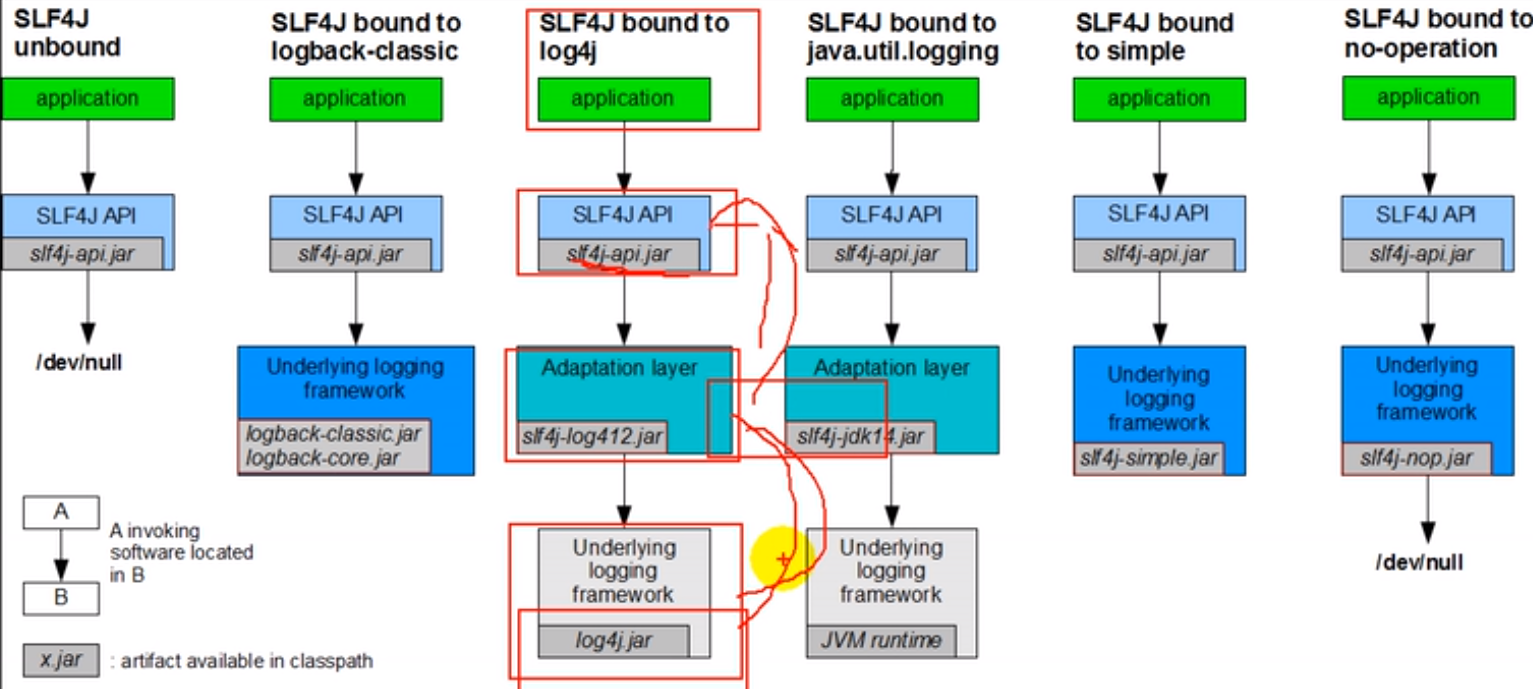
每一个日志的实现框架都有自己的配置文件。使用slf4j以后,配置文件还是做成日志实现框架自己本身的配置文件,连接的话不能直接连接可以使用适配层进行中间件连接;
2、遗留问题
a(slf4j+logback): Spring(commons-logging)、Hibernate(jboss-logging)、MyBatis、xxxx
统一日志记录,即使是别的框架和我一起统一使用slf4j进行输出?
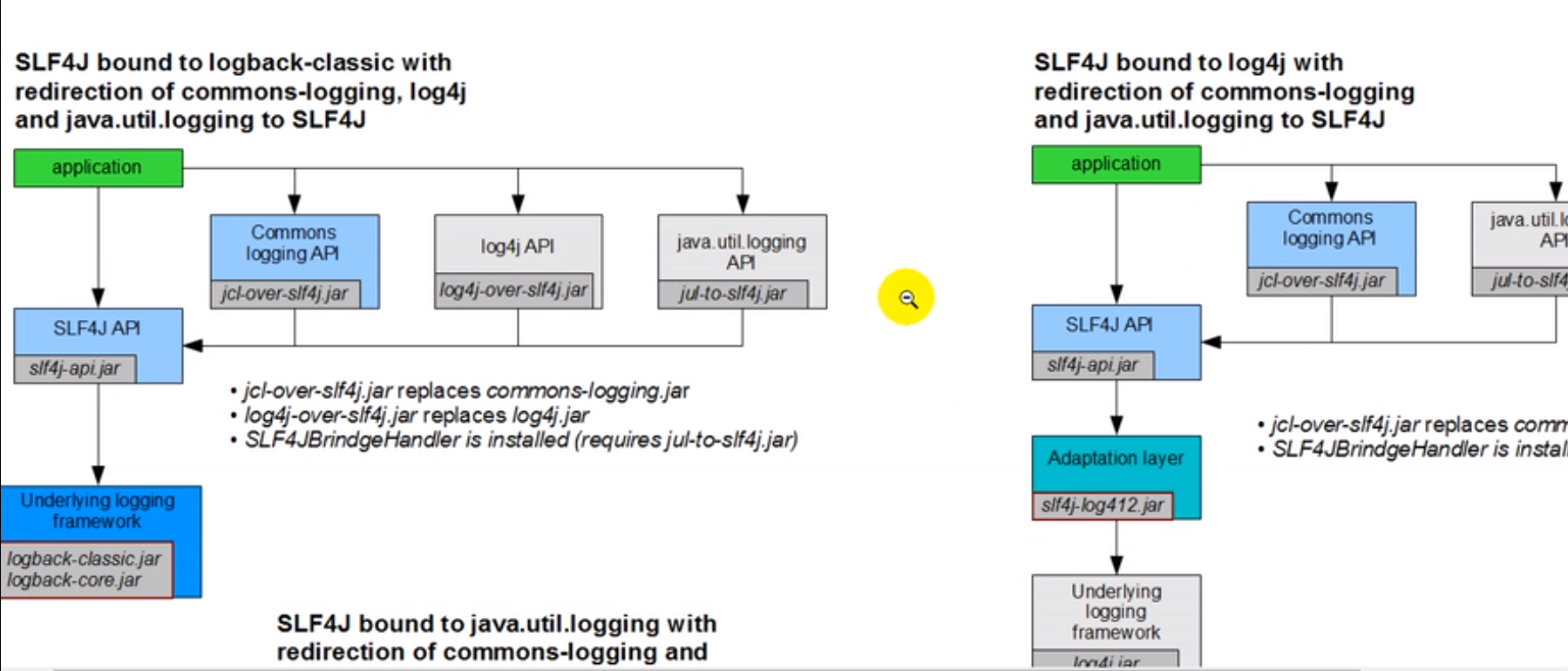
如何让系统中所有的日志都统一到slf4j;
==1、将系统中其他日志框架先排除出去;==
==2、用中间包来替换原有的日志框架;==
==3、我们导入slf4j要使用的其他的日志实现(如使用的日志实现是log4j其他框架的就都使用log4j的ja)==
3、SpringBoot日志关系
1 | <dependency> |
SpringBoot使用它来做日志功能;
1 | <dependency> |
底层依赖关系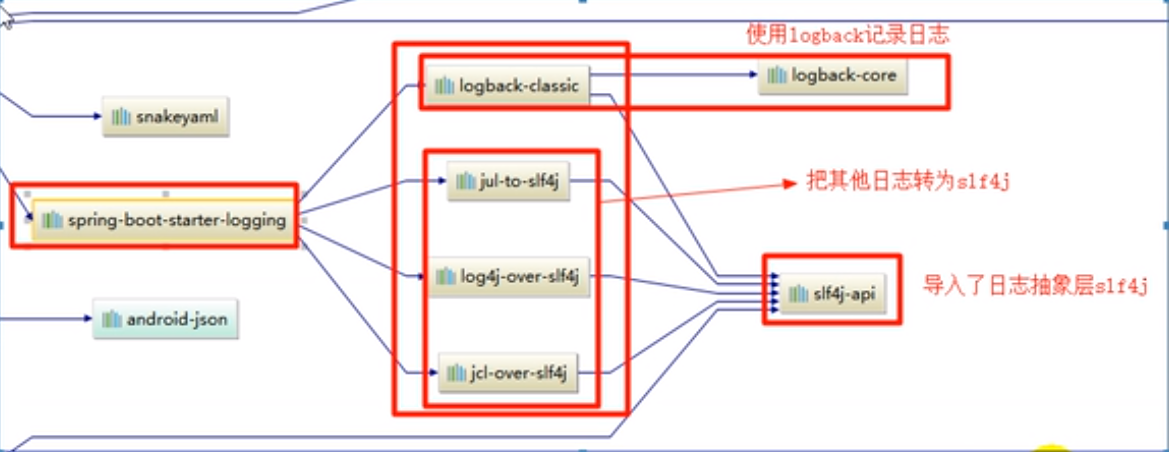
总结:
1)、SpringBoot底层也是使用slf4j+logback的方式进行日志记录
2)、SpringBoot也把其他的日志都替换成了slf4j;
3)、中间替换包?
以下为举例,就是中间包的替换,虽然包名看上去是common.logging的,但里面类的实却是 LogFactory logFactory = new SLF4JLogFactory();
1 | ("rawtypes") |
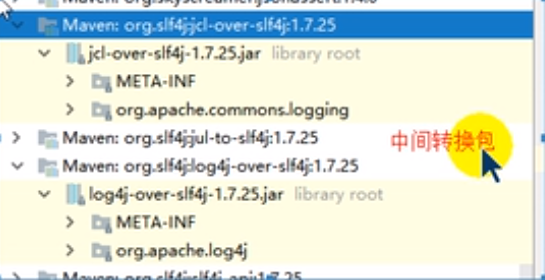
4)、如果我们要引入其他框架?一定要把这个框架的默认日志依赖移除掉?
Spring框架用的是commons-logging;
1 | <dependency> |
==SpringBoot能自动适配所有的日志,而且底层使用slf4j+logback的方式记录日志,引入其他框架的时候,只需要把这个框架依赖的日志框架排除掉即可;==
4、日志使用;
1、默认配置
SpringBoot默认帮我们配置好了日志;
1 | //记录器 |
日志输出格式:
%d表示日期时间,
%thread表示线程名,
%-5level:级别从左显示5个字符宽度
%logger{50} 表示logger名字最长50个字符,否则按照句点分割。
%msg:日志消息,
%n是换行符
-->
%d{yyyy-MM-dd HH:mm:ss.SSS} [%thread] %-5level %logger{50} - %msg%nSpringBoot修改日志的默认配置
1 | logging.level.com.atguigu=trace |
| logging.file | logging.path | Example | Description |
|---|---|---|---|
| (none) | (none) | 只在控制台输出 | |
| 指定文件名 | (none) | my.log | 输出日志到my.log文件 |
| (none) | 指定目录 | /var/log | 输出到指定目录的 spring.log 文件中 |
2、指定配置
给类路径下放上每个日志框架自己的配置文件即可;SpringBoot就不使用他默认配置的了
| Logging System | Customization |
|---|---|
| Logback | logback-spring.xml, logback-spring.groovy, logback.xml or logback.groovy |
| Log4j2 | log4j2-spring.xml or log4j2.xml |
| JDK (Java Util Logging) | logging.properties |
logback.xml:直接就被日志框架识别了;
logback-spring.xml:日志框架就不直接加载日志的配置项,由SpringBoot解析加载日志配置,虽然不直接识别了,但可以使用SpringBoot的高级Profile功能
1 | <springProfile name="staging"> |
如:
1 | <appender name="stdout" class="ch.qos.logback.core.ConsoleAppender"> |
如果使用logback.xml作为日志配置文件,还要使用profile功能,会有以下错误
no applicable action for [springProfile]
5、切换日志框架
可以按照slf4j的日志适配图,进行相关的切换;
slf4j+log4j的方式;(不推荐)
1 | <dependency> |
切换为log4j2
1 | <dependency> |
四、Web开发
1、简介
使用SpringBoot;
1)、创建SpringBoot应用,选中我们需要的模块;
2)、SpringBoot已经默认将这些场景配置好了,只需要在配置文件中指定少量配置就可以运行起来
3)、自己编写业务代码;
自动配置原理?
这个场景SpringBoot帮我们配置了什么?能不能修改?能修改哪些配置?能不能扩展?xxx
1 | xxxxAutoConfiguration:帮我们给容器中自动配置组件; |
2、SpringBoot对静态资源的映射规则;
1 | (prefix = "spring.resources", ignoreUnknownFields = false) |
1 | WebMvcAuotConfiguration: |
==1)、所有 /webjars/** ,都去 classpath:/META-INF/resources/webjars/ 找资源;==
webjars:以jar包的方式引入静态资源;
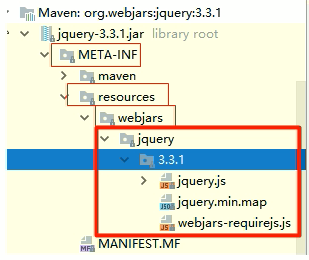
localhost:8080/webjars/jquery/3.3.1/jquery.js
1 | <!--引入jquery-webjar-->在访问的时候只需要写webjars下面资源的名称即可 |
==2)、”/**” 访问当前项目的任何资源,都去(静态资源的文件夹)找映射==
1 | "classpath:/META-INF/resources/", |
以上都是静态文件夹路径
localhost:8080/abc === 去静态资源文件夹里面找abc
==3)、欢迎页; 静态资源文件夹下的所有index.html页面;被”/**”映射;==
localhost:8080/ 找index页面
==4)、所有的 **/favicon.ico 都是在静态资源文件下找(如果页面无法显示图标就按Ctrl+F5 强制刷新就出现了,再不行再清除缓存);==
也可以自定义静态文件夹的路径(但一旦定义了自定义的,默认的public.resources就不再是静态文件夹了,无法默认直接访问了)
3、模板引擎
JSP、Velocity、Freemarker、Thymeleaf

SpringBoot推荐的Thymeleaf;
语法更简单,功能更强大;
1、引入thymeleaf;
1 | <dependency> |
2、Thymeleaf使用
1 | (prefix = "spring.thymeleaf") |
只要我们把HTML页面放在classpath:/templates/,thymeleaf就能自动渲染;
使用:
1、导入thymeleaf的名称空间
1 | <html lang="en" xmlns:th="http://www.thymeleaf.org"> |
2、使用thymeleaf语法;
1 |
|
3、语法规则
1)、th:text;改变当前元素里面的文本内容;
th:任意html属性;来替换原生属性的值
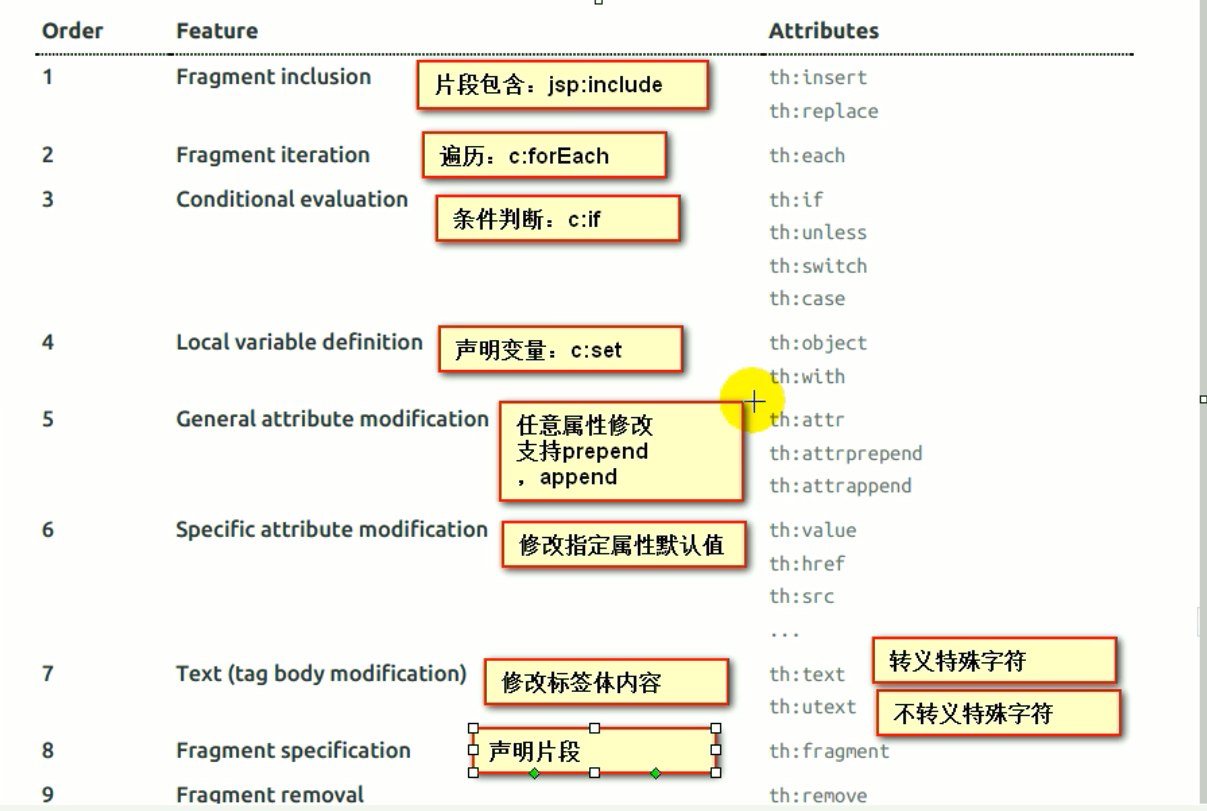
2)、表达式?
1 | Simple expressions:(表达式语法) |
1 | Selection Variable Expressions: *{...}:选择表达式:和${}在功能上是一样; |
4、SpringMVC自动配置
1. Spring MVC auto-configuration
Spring Boot 自动配置好了SpringMVC
以下是SpringBoot对SpringMVC的默认配置:==(WebMvcAutoConfiguration)==
Inclusion of
ContentNegotiatingViewResolverandBeanNameViewResolverbeans.- 自动配置了ViewResolver(视图解析器:根据方法的返回值得到视图对象(View),视图对象决定如何渲染(转发?重定向?))
- ContentNegotiatingViewResolver:组合所有的视图解析器的;
- ==如何定制:我们可以自己给容器中添加一个视图解析器;自动的将其组合进来;==
Support for serving static resources, including support for WebJars (see below).静态资源文件夹路径,webjars
Static
index.htmlsupport. 静态首页访问Custom
Faviconsupport (see below). favicon.ico
自动注册了 of
Converter,GenericConverter,Formatterbeans.- Converter:转换器; public String hello(User user):类型转换使用Converter
Formatter格式化器; 2017.12.17===Date;
1 |
|
==自己添加的格式化器转换器,我们只需要放在容器中即可==
Support for
HttpMessageConverters(see below).HttpMessageConverter:SpringMVC用来转换Http请求和响应的;User—Json;
HttpMessageConverters是从容器中确定;获取所有的HttpMessageConverter;==自己给容器中添加HttpMessageConverter,只需要将自己的组件注册容器中(@Bean,@Component)==
Automatic registration of
MessageCodesResolver(see below).定义错误代码生成规则Automatic use of a
ConfigurableWebBindingInitializerbean (see below).==我们可以配置一个ConfigurableWebBindingInitializer来替换默认的;(添加到容器)==
1
2初始化WebDataBinder;
请求数据=====JavaBean;
org.springframework.boot.autoconfigure.web:web的所有自动场景;
If you want to keep Spring Boot MVC features, and you just want to add additional MVC configuration (interceptors, formatters, view controllers etc.) you can add your own @Configuration class of type WebMvcConfigurerAdapter, but without @EnableWebMvc. If you wish to provide custom instances of RequestMappingHandlerMapping, RequestMappingHandlerAdapter or ExceptionHandlerExceptionResolver you can declare a WebMvcRegistrationsAdapter instance providing such components.
If you want to take complete control of Spring MVC, you can add your own @Configuration annotated with @EnableWebMvc.
2、扩展SpringMVC
1 | <mvc:view-controller path="/hello" view-name="success"/> |
==编写一个配置类(@Configuration),是WebMvcConfigurerAdapter类型;不能标注@EnableWebMvc==;
既保留了所有的自动配置,也能用我们扩展的配置;
1 | //使用WebMvcConfigurerAdapter可以来扩展SpringMVC的功能 |
原理:
1)、WebMvcAutoConfiguration是SpringMVC的自动配置类
2)、在做其他自动配置时会导入;@Import(EnableWebMvcConfiguration.class)
1 |
|
3)、容器中所有的WebMvcConfigurer都会一起起作用;
4)、我们的配置类也会被调用;
效果:SpringMVC的自动配置和我们的扩展配置都会起作用;
3、全面接管SpringMVC;
SpringBoot对SpringMVC的自动配置不需要了,所有都是我们自己配置;所有的SpringMVC的自动配置都失效了
我们需要在配置类中添加@EnableWebMvc即可;
1 | //使用WebMvcConfigurerAdapter可以来扩展SpringMVC的功能 |
原理:
为什么@EnableWebMvc自动配置就失效了;
1)@EnableWebMvc的核心
1 | (DelegatingWebMvcConfiguration.class) |
2)、
1 |
|
3)、
1 |
|
4)、@EnableWebMvc将WebMvcConfigurationSupport组件导入进来;
5)、导入的WebMvcConfigurationSupport只是SpringMVC最基本的功能;
5、如何修改SpringBoot的默认配置
模式:
1)、SpringBoot在自动配置很多组件的时候,先看容器中有没有用户自己配置的(@Bean、@Component)如果有就用用户配置的,如果没有,才自动配置;如果有些组件可以有多个(ViewResolver)将用户配置的和自己默认的组合起来;
2)、在SpringBoot中会有非常多的xxxConfigurer帮助我们进行扩展配置
3)、在SpringBoot中会有很多的xxxCustomizer帮助我们进行定制配置
6、RestfulCRUD
1)、默认访问首页
1 |
|
2)、国际化
1)、编写国际化配置文件;
2)、使用ResourceBundleMessageSource管理国际化资源文件
3)、在页面使用fmt:message取出国际化内容
步骤:
1)、编写国际化配置文件,抽取页面需要显示的国际化消息
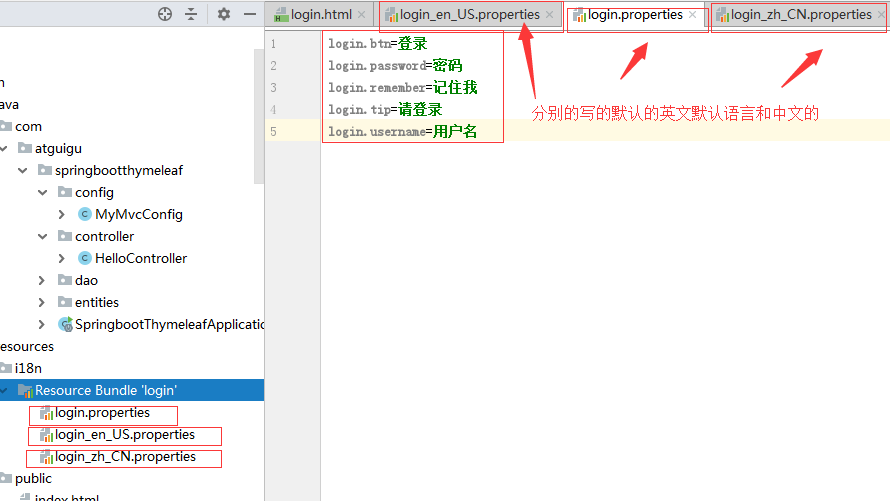
2)、SpringBoot自动配置好了管理国际化资源文件的组件;
1 | (prefix = "spring.messages") |
3)、去页面获取国际化的值;
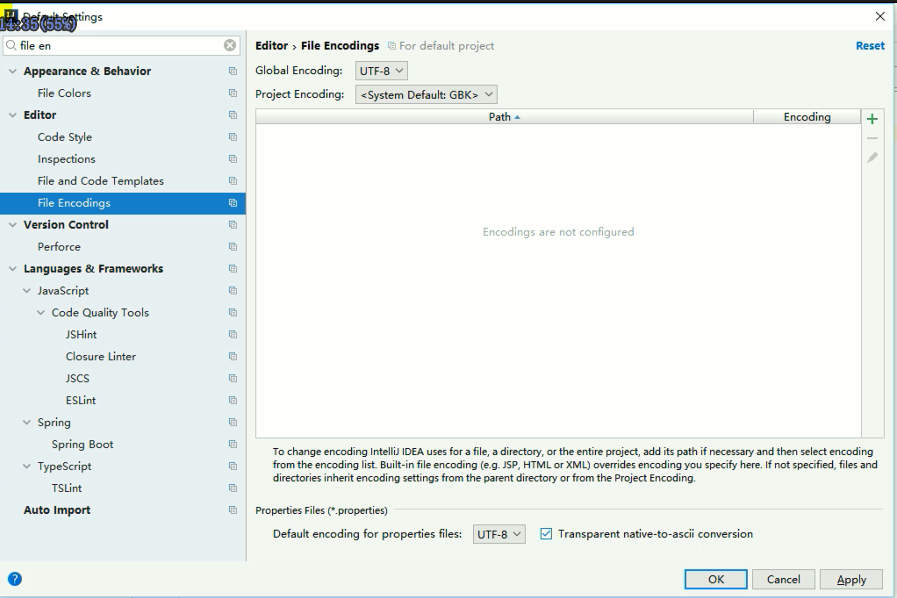
1 |
|
效果:根据浏览器语言设置的信息切换了国际化;
原理:
国际化Locale(区域信息对象);LocaleResolver(获取区域信息对象);
1 |
|
默认的就是根据请求头带来的区域信息获取Locale进行国际化
4)、点击链接切换国际化
1 | /** |
3)、登陆
开发期间模板引擎页面修改以后,要实时生效
1)、禁用模板引擎的缓存
1 | # 禁用缓存 |
2)、页面修改完成以后ctrl+f9:重新编译;
登陆错误消息的显示
1 | <p style="color: red" th:text="${msg}" th:if="${not #strings.isEmpty(msg)}"></p> |
4)、拦截器进行登陆检查
拦截器
1 |
|
注册拦截器
1 | //所有的WebMvcConfigurerAdapter组件都会一起起作用 |
5)、CRUD-员工列表
实验要求:
1)、RestfulCRUD:CRUD满足Rest风格;
URI: /资源名称/资源标识 HTTP请求方式区分对资源CRUD操作
| 普通CRUD(uri来区分操作) | RestfulCRUD | |
|---|---|---|
| 查询 | getEmp | emp—GET |
| 添加 | addEmp?xxx | emp—POST |
| 修改 | updateEmp?id=xxx&xxx=xx | emp/{id}—PUT |
| 删除 | deleteEmp?id=1 | emp/{id}—DELETE |
2)、实验的请求架构;
| 实验功能 | 请求URI | 请求方式 |
|---|---|---|
| 查询所有员工 | emps | GET |
| 查询某个员工(来到修改页面) | emp/1 | GET |
| 来到添加页面 | emp | GET |
| 添加员工 | emp | POST |
| 来到修改页面(查出员工进行信息回显) | emp/1 | GET |
| 修改员工 | emp | PUT |
| 删除员工 | emp/1 | DELETE |
3)、员工列表:
thymeleaf公共页面元素抽取
1 | 1、抽取公共片段 |
三种引入公共片段的th属性:
th:insert:将公共片段整个插入到声明引入的元素中
th:replace:将声明引入的元素替换为公共片段
th:include:将被引入的片段的内容包含进这个标签中
1 | <footer th:fragment="copy"> |
引入片段的时候传入参数:
1 |
|
6)、CRUD-员工添加
添加页面
1 | <form> |
提交的数据格式不对:生日:日期;
2017-12-12;2017/12/12;2017.12.12;
日期的格式化;SpringMVC将页面提交的值需要转换为指定的类型;
2017-12-12—Date; 类型转换,格式化;
默认日期是按照/的方式;
7)、CRUD-员工修改
修改添加二合一表单
1 | <!--需要区分是员工修改还是添加;--> |
8)、CRUD-员工删除
1 | <tr th:each="emp:${emps}"> |
7、错误处理机制
1)、SpringBoot默认的错误处理机制
默认效果:
1)、浏览器,返回一个默认的错误页面

浏览器发送请求的请求头:

2)、如果是其他客户端,默认响应一个json数据


原理:
可以参照ErrorMvcAutoConfiguration;错误处理的自动配置;
给容器中添加了以下组件 1、DefaultErrorAttributes:
1 | 帮我们在页面共享信息; |
2、BasicErrorController:处理默认/error请求
1 |
|
3、ErrorPageCustomizer:
1 | ("${error.path:/error}") |
4、DefaultErrorViewResolver:
1 |
|
步骤:
一但系统出现4xx或者5xx之类的错误;ErrorPageCustomizer就会生效(定制错误的响应规则);就会来到/error请求;就会被BasicErrorController处理;
1)响应页面;去哪个页面是由DefaultErrorViewResolver解析得到的;
1 | protected ModelAndView resolveErrorView(HttpServletRequest request, |
2)、如果定制错误响应:
1)、如何定制错误的页面;
1)、有模板引擎的情况下;error/状态码; 【将错误页面命名为 错误状态码.html 放在模板引擎文件夹里面的 error文件夹下】,发生此状态码的错误就会来到 对应的页面;
我们可以使用4xx和5xx作为错误页面的文件名来匹配这种类型的所有错误,精确优先(优先寻找精确的状态码.html);
页面能获取的信息;
timestamp:时间戳
status:状态码
error:错误提示
exception:异常对象
message:异常消息
errors:JSR303数据校验的错误都在这里
2)、没有模板引擎(模板引擎找不到这个错误页面),静态资源文件夹下找;
3)、以上都没有错误页面,就是默认来到SpringBoot默认的错误提示页面;
2)、如何定制错误的json数据;
1)、自定义异常处理&返回定制json数据;
1 |
|
2)、转发到/error进行自适应响应效果处理
1 | (UserNotExistException.class) |
3)、将我们的定制数据携带出去;
出现错误以后,会来到/error请求,会被BasicErrorController处理,响应出去可以获取的数据是由getErrorAttributes得到的(是AbstractErrorController(ErrorController)规定的方法);
1、完全来编写一个ErrorController的实现类【或者是编写AbstractErrorController的子类】,放在容器中;
2、页面上能用的数据,或者是json返回能用的数据都是通过errorAttributes.getErrorAttributes得到;
容器中DefaultErrorAttributes.getErrorAttributes();默认进行数据处理的;
自定义ErrorAttributes
1 | //给容器中加入我们自己定义的ErrorAttributes |
最终的效果:响应是自适应的,可以通过定制ErrorAttributes改变需要返回的内容,

8、配置嵌入式Servlet容器
SpringBoot默认使用Tomcat作为嵌入式的Servlet容器;

问题?
1)、如何定制和修改Servlet容器的相关配置;
1、修改和server有关的配置(ServerProperties【也是EmbeddedServletContainerCustomizer】);
1 | server.port=8081 |
2、编写一个EmbeddedServletContainerCustomizer:嵌入式的Servlet容器的定制器;来修改Servlet容器的配置
1 | //一定要将这个定制器加入到容器中 |
2)、注册Servlet三大组件【Servlet、Filter、Listener】
由于SpringBoot默认是以jar包的方式启动嵌入式的Servlet容器来启动SpringBoot的web应用,没有web.xml文件。
注册三大组件用以下方式
ServletRegistrationBean
1 | //注册三大组件 |
FilterRegistrationBean
1 |
|
ServletListenerRegistrationBean
1 |
|
SpringBoot帮我们自动SpringMVC的时候,自动的注册SpringMVC的前端控制器;DIspatcherServlet;
DispatcherServletAutoConfiguration中:
1 | (name = DEFAULT_DISPATCHER_SERVLET_REGISTRATION_BEAN_NAME) |
2)、SpringBoot能不能支持其他的Servlet容器;
3)、替换为其他嵌入式Servlet容器

默认支持:
Tomcat(默认使用)
1 | <dependency> |
Jetty
1 | <!-- 引入web模块 --> |
Undertow
1 | <!-- 引入web模块 --> |
4)、嵌入式Servlet容器自动配置原理;
EmbeddedServletContainerAutoConfiguration:嵌入式的Servlet容器自动配置?
1 | (Ordered.HIGHEST_PRECEDENCE) |
1)、EmbeddedServletContainerFactory(嵌入式Servlet容器工厂)
1 | public interface EmbeddedServletContainerFactory { |

2)、EmbeddedServletContainer:(嵌入式的Servlet容器)

3)、以TomcatEmbeddedServletContainerFactory为例
1 |
|
4)、我们对嵌入式容器的配置修改是怎么生效?
1 | ServerProperties、EmbeddedServletContainerCustomizer |
EmbeddedServletContainerCustomizer:定制器帮我们修改了Servlet容器的配置?
怎么修改的原理?
5)、容器中导入了EmbeddedServletContainerCustomizerBeanPostProcessor
1 | //初始化之前 |
步骤:
1)、SpringBoot根据导入的依赖情况,给容器中添加相应的EmbeddedServletContainerFactory【TomcatEmbeddedServletContainerFactory】
2)、容器中某个组件要创建对象就会惊动后置处理器;EmbeddedServletContainerCustomizerBeanPostProcessor;
只要是嵌入式的Servlet容器工厂,后置处理器就工作;
3)、后置处理器,从容器中获取所有的EmbeddedServletContainerCustomizer,调用定制器的定制方法
###5)、嵌入式Servlet容器启动原理;
什么时候创建嵌入式的Servlet容器工厂?什么时候获取嵌入式的Servlet容器并启动Tomcat;
获取嵌入式的Servlet容器工厂:
1)、SpringBoot应用启动运行run方法
2)、refreshContext(context);SpringBoot刷新IOC容器【创建IOC容器对象,并初始化容器,创建容器中的每一个组件】;如果是web应用创建AnnotationConfigEmbeddedWebApplicationContext,否则:AnnotationConfigApplicationContext
3)、refresh(context);刷新刚才创建好的ioc容器;
1 | public void refresh() throws BeansException, IllegalStateException { |
4)、 onRefresh(); web的ioc容器重写了onRefresh方法
5)、webioc容器会创建嵌入式的Servlet容器;createEmbeddedServletContainer();
6)、获取嵌入式的Servlet容器工厂:
EmbeddedServletContainerFactory containerFactory = getEmbeddedServletContainerFactory();
从ioc容器中获取EmbeddedServletContainerFactory 组件;TomcatEmbeddedServletContainerFactory创建对象,后置处理器一看是这个对象,就获取所有的定制器来先定制Servlet容器的相关配置;
7)、使用容器工厂获取嵌入式的Servlet容器:this.embeddedServletContainer = containerFactory .getEmbeddedServletContainer(getSelfInitializer());
8)、嵌入式的Servlet容器创建对象并启动Servlet容器;
先启动嵌入式的Servlet容器,再将ioc容器中剩下没有创建出的对象获取出来;
==IOC容器启动创建嵌入式的Servlet容器==
9、使用外置的Servlet容器
嵌入式Servlet容器:应用打成可执行的jar
优点:简单、便携;
缺点:默认不支持JSP、优化定制比较复杂(使用定制器【ServerProperties、自定义EmbeddedServletContainerCustomizer】,自己编写嵌入式Servlet容器的创建工厂【EmbeddedServletContainerFactory】);
外置的Servlet容器:外面安装Tomcat—应用war包的方式打包;
步骤
1)、必须创建一个war项目;(利用idea创建好目录结构)
2)、将嵌入式的Tomcat指定为provided;
1 | <dependency> |
3)、必须编写一个SpringBootServletInitializer的子类,并调用configure方法
1 | public class ServletInitializer extends SpringBootServletInitializer { |
4)、启动服务器就可以使用;
原理
jar包:执行SpringBoot主类的main方法,启动ioc容器,创建嵌入式的Servlet容器;
war包:启动服务器,服务器启动SpringBoot应用【SpringBootServletInitializer】,启动ioc容器;
servlet3.0(Spring注解版):
8.2.4 Shared libraries / runtimes pluggability:
规则:
1)、服务器启动(web应用启动)会创建当前web应用里面每一个jar包里面ServletContainerInitializer实例:
2)、ServletContainerInitializer的实现放在jar包的META-INF/services文件夹下,有一个名为javax.servlet.ServletContainerInitializer的文件,内容就是ServletContainerInitializer的实现类的全类名
3)、还可以使用@HandlesTypes,在应用启动的时候加载我们感兴趣的类;
流程:
1)、启动Tomcat
2)、org\springframework\spring-web\4.3.14.RELEASE\spring-web-4.3.14.RELEASE.jar!\META-INF\services\javax.servlet.ServletContainerInitializer:
Spring的web模块里面有这个文件:org.springframework.web.SpringServletContainerInitializer
3)、SpringServletContainerInitializer将@HandlesTypes(WebApplicationInitializer.class)标注的所有这个类型的类都传入到onStartup方法的Set<Class<?>>;为这些WebApplicationInitializer类型的类创建实例;
4)、每一个WebApplicationInitializer都调用自己的onStartup;

5)、相当于我们的SpringBootServletInitializer的类会被创建对象,并执行onStartup方法
6)、SpringBootServletInitializer实例执行onStartup的时候会createRootApplicationContext;创建容器
1 | protected WebApplicationContext createRootApplicationContext( |
7)、Spring的应用就启动并且创建IOC容器
1 | public ConfigurableApplicationContext run(String... args) { |
==启动Servlet容器,再启动SpringBoot应用==
五、Docker
1、简介
Docker是一个开源的应用容器引擎;是一个轻量级容器技术;
Docker支持将软件编译成一个镜像;然后在镜像中各种软件做好配置,将镜像发布出去,其他使用者可以直接使用这个镜像;
运行中的这个镜像称为容器,容器启动是非常快速的。


2、核心概念
docker主机(Host):安装了Docker程序的机器(Docker直接安装在操作系统之上);
docker客户端(Client):连接docker主机进行操作;
docker仓库(Registry):用来保存各种打包好的软件镜像;
docker镜像(Images):软件打包好的镜像;放在docker仓库中;
docker容器(Container):镜像启动后的实例称为一个容器;容器是独立运行的一个或一组应用

使用Docker的步骤:
1)、安装Docker
2)、去Docker仓库找到这个软件对应的镜像;
3)、使用Docker运行这个镜像,这个镜像就会生成一个Docker容器;
4)、对容器的启动停止就是对软件的启动停止;
3、安装Docker
1)、安装linux虚拟机
1)、VMWare、VirtualBox(安装);
2)、导入虚拟机文件centos7-atguigu.ova;
3)、双击启动linux虚拟机;使用 root/ 123456登陆
4)、使用客户端连接linux服务器进行命令操作;
5)、设置虚拟机网络;
桥接网络===选好网卡====接入网线;
6)、设置好网络以后使用命令重启虚拟机的网络
1 | service network restart |
7)、查看linux的ip地址
1 | ip addr |
8)、使用客户端连接linux;
2)、在linux虚拟机上安装docker
步骤:
1 | 1、检查内核版本,必须是3.10及以上 |
4、Docker常用命令&操作
1)、镜像操作
| 操作 | 命令 | 说明 |
|---|---|---|
| 检索 | docker search 关键字 eg:docker search redis | 我们经常去docker hub上检索镜像的详细信息,如镜像的TAG。 |
| 拉取 | docker pull 镜像名:tag | :tag是可选的,tag表示标签,多为软件的版本,默认是latest |
| 列表 | docker images | 查看所有本地镜像 |
| 删除 | docker rmi image-id | 删除指定的本地镜像 |
2)、容器操作
软件镜像(QQ安装程序)—-运行镜像—-产生一个容器(正在运行的软件,运行的QQ);
步骤:
1 | 1、搜索镜像 |
3)、安装MySQL示例
1 | docker pull mysql |
错误的启动
1 | [root@localhost ~]# docker run --name mysql01 -d mysql |
正确的启动
1 | [root@localhost ~]# docker run --name mysql01 -e MYSQL_ROOT_PASSWORD=123456 -d mysql |
做了端口映射
1 | [root@localhost ~]# docker run -p 3306:3306 --name mysql02 -e MYSQL_ROOT_PASSWORD=123456 -d mysql |
几个其他的高级操作
1 | docker run --name mysql03 -v /conf/mysql:/etc/mysql/conf.d -e MYSQL_ROOT_PASSWORD=my-secret-pw -d mysql:tag |
六、SpringBoot与数据访问
1、JDBC
1 | <dependency> |
1 | spring: |
效果:
默认是用org.apache.tomcat.jdbc.pool.DataSource作为数据源;
数据源的相关配置都在DataSourceProperties里面;
自动配置原理:
org.springframework.boot.autoconfigure.jdbc:
1、参考DataSourceConfiguration,根据配置创建数据源,默认使用Tomcat连接池;可以使用spring.datasource.type指定自定义的数据源类型;
2、SpringBoot默认可以支持;
1 | org.apache.tomcat.jdbc.pool.DataSource、HikariDataSource、BasicDataSource、 |
3、自定义数据源类型
1 | /** |
4、DataSourceInitializer:ApplicationListener;
作用:
1)、runSchemaScripts();运行建表语句;
2)、runDataScripts();运行插入数据的sql语句;
默认只需要将文件命名为:
1 | schema-*.sql、data-*.sql |
5、操作数据库:自动配置了JdbcTemplate操作数据库
2、整合Druid数据源
1 | 导入druid数据源 |
3、整合MyBatis
1 | <dependency> |

步骤:
1)、配置数据源相关属性(见上一节Druid)
2)、给数据库建表
3)、创建JavaBean
4)、注解版
1 | //指定这是一个操作数据库的mapper |
问题:
自定义MyBatis的配置规则;给容器中添加一个ConfigurationCustomizer;
1 | .springframework.context.annotation.Configuration |
1 | 使用MapperScan批量扫描所有的Mapper接口; |
5)、配置文件版
1 | mybatis: |
更多使用参照
http://www.mybatis.org/spring-boot-starter/mybatis-spring-boot-autoconfigure/
4、整合SpringData JPA
1)、SpringData简介

2)、整合SpringData JPA
JPA:ORM(Object Relational Mapping);
1)、编写一个实体类(bean)和数据表进行映射,并且配置好映射关系;
1 | //使用JPA注解配置映射关系 |
2)、编写一个Dao接口来操作实体类对应的数据表(Repository)
1 | //继承JpaRepository来完成对数据库的操作 |
3)、基本的配置JpaProperties
1 | spring: |
七、启动配置原理
几个重要的事件回调机制
配置在META-INF/spring.factories
ApplicationContextInitializer
SpringApplicationRunListener
只需要放在ioc容器中
ApplicationRunner
CommandLineRunner
启动流程:
1、创建SpringApplication对象
1 | initialize(sources); |


2、运行run方法
1 | public ConfigurableApplicationContext run(String... args) { |
3、事件监听机制
配置在META-INF/spring.factories
ApplicationContextInitializer
1 | public class HelloApplicationContextInitializer implements ApplicationContextInitializer<ConfigurableApplicationContext> { |
SpringApplicationRunListener
1 | public class HelloSpringApplicationRunListener implements SpringApplicationRunListener { |
配置(META-INF/spring.factories)
1 | org.springframework.context.ApplicationContextInitializer=\ |
只需要放在ioc容器中
ApplicationRunner
1 |
|
CommandLineRunner
1 |
|
八、自定义starter
starter:
1、这个场景需要使用到的依赖是什么?
2、如何编写自动配置
1 | //指定这个类是一个配置类 |
3、模式:
启动器只用来做依赖导入;
专门来写一个自动配置模块;
启动器依赖自动配置;别人只需要引入启动器(starter)
mybatis-spring-boot-starter;自定义启动器名-spring-boot-starter
步骤:
1)、启动器模块
1 |
|
2)、自动配置模块
1 |
|
1 | package com.atguigu.starter; |
1 | package com.atguigu.starter; |
1 | package com.atguigu.starter; |
更多SpringBoot整合示例
https://github.com/spring-projects/spring-boot/tree/master/spring-boot-samples